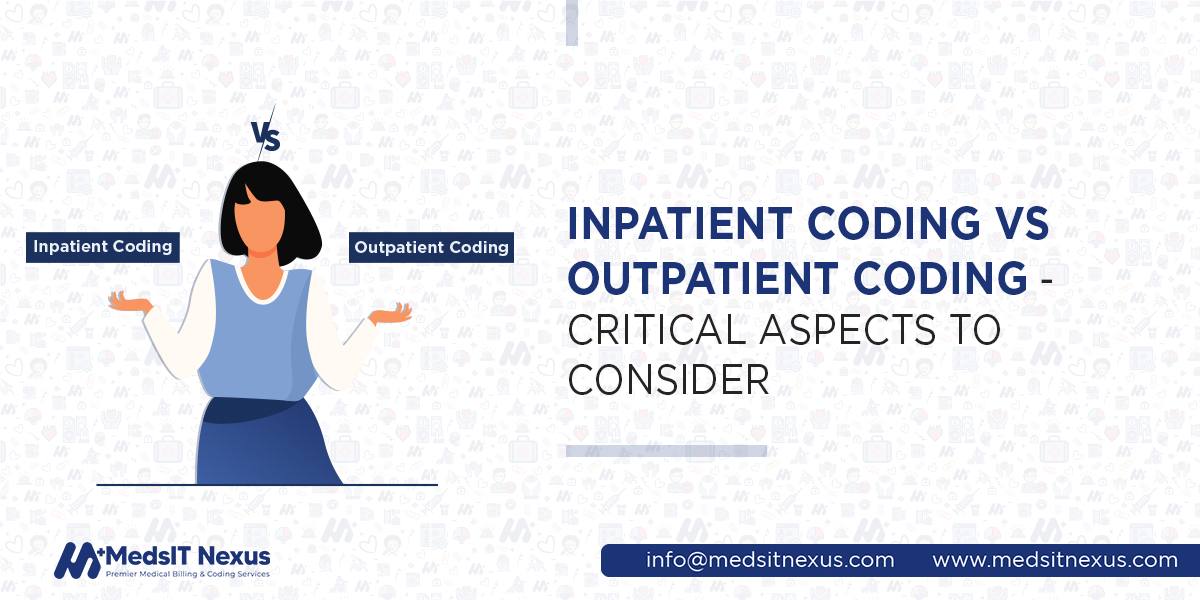Inpatient coding vs outpatient coding - Critical Aspects to Consider

Navigating the intricate landscape of inpatient coding requires a seasoned understanding of medical
procedures, diagnoses and an adept familiarity with the complex framework of Diagnosis-Related Group
(DRG) coding. As an experienced inpatient coder, I am excited to delve into the nuances of this vital
coding process in the realm of healthcare.
As in healthcare financial operations, inpatient coding establishes the fundamental basis for precise
medical billing and reimbursement; this blog post will unravel the multifaceted layers of inpatient
coding, elucidating the methodologies employed to translate intricate patient records into a
standardized code set of the ICD 10 PCS codes for procedures. However, it's crucial to note that
challenges often arise within the realm of DRG coding, with complications stemming from factors such as
the presence of Comorbid Conditions, as in this situation, along with the implication of diagnosis
codes, Medicare Severity Diagnosis Related Groups (MS-DRGs) codes are also assigned.
With the presence of comorbid conditions and the complications associated with inpatient medical coding,
many medical organizations rely on the proficient services rendered by seasoned medical billing and
coding experts; in this regard, MedsIT Nexus inpatient medical coding services
are paving a path to
accuracy because we have certified Inpatient Coders with years of experience.
Inpatient Coding and Outpatient Coding – Key Differences
Inpatient medical coding comprises several technical aspects of comorbid condition coding that only the experienced medical coder can understand and have the capability of maintaining the standard initiated by Medicare. Before we get into it, it is critical to understand the basic difference between both inpatient and outpatient coding.
| Inpatient | Outpatient | |
|---|---|---|
| Description | "Inpatient" refers to the status assigned to a patient who has been officially admitted to a healthcare facility as directed by a physician. This admission can occur in various settings, such as hospitals, nursing homes, rehabilitation facilities, or long-term care facilities, and is typically associated with an extended period of care. It's important to understand that merely spending a night in the hospital does not automatically classify a patient as an inpatient. | "Outpatient" describes a patient who receives medical treatment and care within a healthcare facility but is not formally admitted for an extended stay. Typically, outpatient care involves patients who are discharged from the facility within 24 hours of their treatment. This outpatient classification persists even if the patient's stay surpasses the 24-hour mark as long as the physician has not prescribed their admission as an inpatient. |
| Code Assignment, | The coding process utilizes both the ICD-10-CM and ICD-10-PCS
coding manuals. The ICD-10-PCS
coding system is specifically reserved for inpatient care within U.S. hospital settings. It's
important to highlight that ICD-10-PCS excludes routine procedures, and laboratory tests, and
educational sessions that are not distinctively tied to the inpatient hospital
environment. In the inpatient coding, along with these codes assignment, MS-DRG codes are also used, where the comorbid condition is always taken into the consideration |
Outpatient coding employs diagnostic codes from ICD-10-CM as well as CPT and HCPCS level II codes. These codes are tailored to capture services and resources delivered to the outpatient context. The process of assigning CPT and HCPCS codes relies significantly on thorough documentation. |
| Duration of stay | Inpatient coding is more complex as compared to outpatient coding because of the comorbid condition that causes an increase in the patient’s length of stay and additional treatment. A presence of such a pre-existing condition increases the reimbursement along with the requirement for patient care | Outpatient coding revolves around determining codes according to the specific visit or interaction. It comes into play when a patient undergoes medical care within a facility but does not extend their stay beyond 24 hours. |
| Reimbursement | Primarily based on a diagnosis-related group (DRG) | Primarily based on the physician charges, contracted rates with insurance, and rates applicable to ambulatory surgical centers. |
| Reimbursement Services | Inpatient services fall under medicare part A, which covers hospital insurance, patients care in hospital, skilled nursing facilities, nursing home care, hospice care, and home healthcare | Outpatient services are covered as part of medicare part B, which covers medical expenses like doctor’s visits, diagnostic tests, preventative care, and other outpatient care |
Comorbidity, Complications - inpatient coding complexities
In the realm of medical coding, particularly when dealing with comorbid conditions, complications
impact the billing process and overall medical decision-making. One important aspect is
distinguishing between comorbid conditions and signs/symptoms, as this differentiation plays a
crucial role in accurately coding and billing for services.
A comorbid condition refers to a secondary condition that coexists with the primary condition being
treated. It may not directly cause the treated condition but can influence the patient's overall
health and treatment plan.
For instance, if a patient is being treated for a respiratory infection but they also have diabetes
or chronic kidney disease, these additional conditions are considered comorbidities. Now, the
physician has to treat chronic kidney disease; hence the cost of service gets increased, and the
reimbursement also increases proportionally. Chronic kidney disease meets the definition of a
secondary diagnosis.
In the above scenario, the implication of the MS-DRG will differ. While coding the respiratory
infection, the DRG will be of less dollar value, but will the entry of chronic kidney disease, the
DRG code will be different and will have high value than the previous one. This is the actual effect
of Comorbid conditions. Therefore, any Comorbid condition should not be missed in the Inpatient
coding because they are mainly responsible for the increase in the payment of the services. In
another case, the physician or hospitals will not get fully reimbursed.
The complication is not the same thing as comorbidity because it occurs after the patient is
admitted to the hospital. It is not a pre-existing condition like a Comorbid Condition. This also
affects the treatment received by the patient; increasing the length of stay of patients in the
hospital obviously increases the reimbursement.
It is critical to code the complications as a secondary diagnosis. The sole exemption to this rule
is when a patient is admitted for addressing a complication stemming from a previous admission. In
this case, the complication qualifies as the principal diagnosis.
If the medical condition is not part of the routine care of an anticipated procedure. The physician
must document that the condition is a complication.
On the other hand, signs and symptoms are direct manifestations of the primary condition. For
example, if a patient is being treated for a severe cough, the cough itself is a symptom of the
underlying issue and should not be coded separately.
A potential complication in medical coding arises when comorbid conditions are not properly
identified and coded. If a comorbid condition is not documented and coded accurately, it can lead to
an underestimation of the patient's health status complexity. This, in turn, would result in
inaccurate billing and reimbursement and an incomplete representation of the patient's overall
medical needs.
It is critical to seek clarification from the healthcare provider when the documentation lacks
clarity for the purpose of coding complications. For instance, in cases where the progress note
outlines a postoperative fever, we can proceed with coding it as a complication. However, if the
provider's documentation solely mentions fever during the postoperative period without specifying
its relationship to the procedure, it becomes necessary to initiate a query with the physician to
confirm whether it constitutes a complication arising from the performed procedure.
From a billing perspective, if comorbid conditions impact the medical decision-making process during
evaluation and treatment, it is crucial to code these conditions appropriately. Proper coding of
comorbidities provides a comprehensive picture of the patient's health status and ensures that the
level of service billed accurately reflects the complexity of care required.
Additionally, from a Medicare standpoint, there is a special emphasis on coding chronic conditions,
especially those designated with Hierarchical Condition Category (HCC) codes in the ICD-10-CM
manual. These chronic conditions play a key role in risk adjustment coding, which helps account for
the varying health risks and complexities of patients within a population. Regardless of whether
these chronic conditions directly impact medical decision-making for a specific encounter, coding
them accurately contributes to a more comprehensive and accurate representation of the patient's
long-term health status.
In summary, accurately coding Comorbid conditions and Complications is essential for proper billing,
effective communication with payors, and ensuring that the level of service billed aligns with the
complexity of care provided. Careful consideration of the distinction between comorbid conditions
and signs/symptoms and a thorough understanding of risk adjustment coding principles is vital in
this process.
Samuel White, MBA-HC, CPAR -
Lead Author & Senior Healthcare Revenue Cycle Strategist at MedsIT Nexus
Leads editorial process for the publication of Technical RCM guides, reimbursement optimization case studies, and compliance-focused research content, expert evaluations of RCM software and medical billing solutions.






